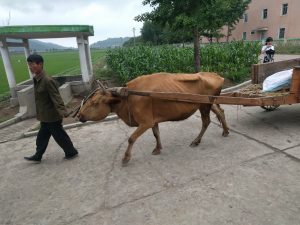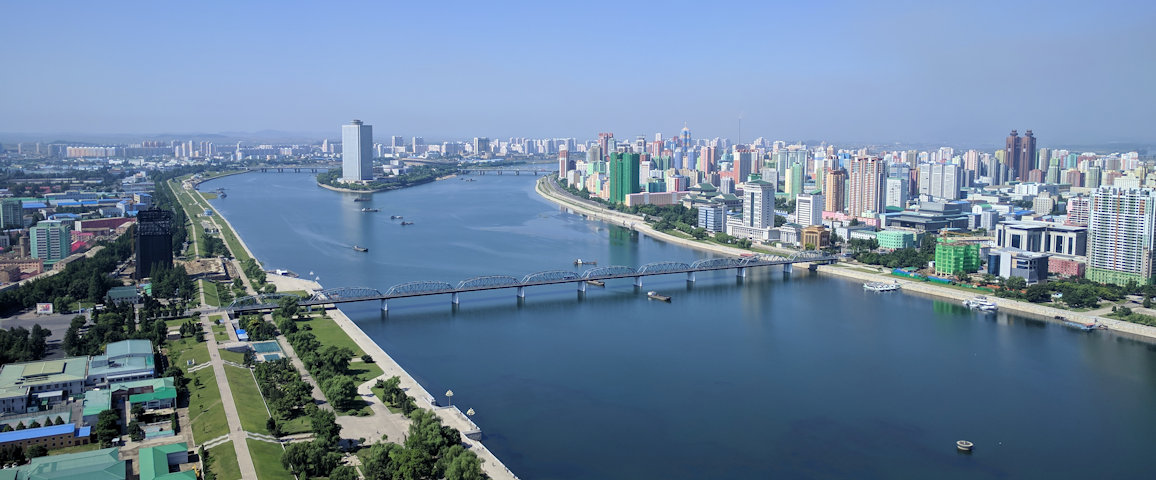In April a Japanese newspaper revealed a policy document purportedly detailing the Democratic People’s Republic of Korea’s economic strategy for the 2016-2020 period.
The text’s authors stressed the need to step-up technological development, diversify the country’s trade, chiefly toward Russia, and proceed with the “full introduction of a new economic management method.”
What “new management method” could they be referring to? Most western reports on DPRK economic affairs tend to speculate on Kim Jong Un’s desire to emulate Chinese- or Vietnamese-style reforms, while hesitating to suggest that anything tangible is yet in place. They usually allude to the presence of private markets throughout the country, explaining these as a result of the collapse or near-collapse of the socialist country’s public food distribution system during the “Arduous March” (severe shortages and famine during the 1990s). But these markets, while taxed, are frequently said to be merely tolerated by the government, occupants of a grey legal zone.
As I learned during a June visit to People’s Korea – accompanied by a long-time friend and notable PV supporter – getting clear answers to this and related questions can be difficult. Nobody seems to know much about reforms, and one is told that things are much better than some years ago. Otherwise, all is essentially as it was, running according to the intentions of founding hero Kim Il Sung.
But change is afoot. Pyongyang’s pastel-hued skyline is spreading, rising, and getting slicker, as frequent visitors and residents note. Restaurants are busy, shops are crammed with goods, and people play racquet sports in courts near the gorgeous Taedong River. People wield cell phones without pause – not just in Pyongyang – and hurtle along on electric bikes. Women especially dress fashionably, although my companion observed they are not quite as up-to-date as the Chinese.
So back to the question, What’s behind the evident changes?
Enterprises’ new autonomy
The “new management method” refers to a 2014 amendment to the Enterprise Act. This semi-revolutionary law acknowledges the right of State organizations, down to the local level, to create companies. It confers decision-making authority on enterprise directors and obliges firms to come up with plans that suit their own circumstances. It permits domestic firms to engage in foreign ventures and form joint ventures.
According to Peter Ward, writing for DPRK-devoted website 38north.org, the amended Act specifically permits companies to draw on the “unused cash of residents” to fund activities – in other words, to seek private investors.
The central People’s Economic Plan doesn’t vanish, but becomes more “nebulous,” in Ward’s word. Think China and Yugoslavia prior to its dissolution.
Others argue that what is emerging in the DPRK is an economy led by large public conglomerates taking advantage of new rules to establish diverse interests, such as an airline, taxis and soft-drinks under one roof, or hotels, ski resorts and mineral water-bottling operations under another.
Last year, Supreme Leader Kim Jong Un told Koreans that the dual policy of concentrating on economic development and securing a nuclear deterrent had run its course, in the sense that the latter had been achieved. The Workers’ Party and its dynamic young leader have henceforth become irrevocably committed to raising living standards. That is the measure by which they will be judged, barring some dramatic event.
In this context we can understand the vigorous attempts from Pyongyang to reach an acceptable accord with the United States. Reforms require opening up, and opening up is crippled by sanctions.
DPRK policy makers never forget the ultimate goal reunification of the peninsula under Pyongyang’s leadership. “One country/two systems” is the immediate model for this objective; socialism need not be a casualty of reunification, but such an outcome is conceivable only with an economically dynamic North. Were Kim Jong Un to accomplish this project in his lifetime, he truly would be his grandfather’s boy.
Food security a major challenge
Crossing the Yalu River (Amnok in Korean) from the Chinese city Dandong into the DPRK, and proceeding south of Sinuiju, one sees hours of countryside. The view is of a great, green agricultural plain with significant rises in the landscape only in the distance. What is striking is the apparent devotion of every square mm to raising food. Looking out, you see the flooded fields of rice, crisscrossed by raised paths on which step farmers and kids back from school.
As one drives across the DPRK – from Pyongyang to Nampho, to Kaesong, back to Sariwon, to Wonsan on the east coast and northward – the topographical changes are often dramatic, but the constant is rice, maize, potatoes, fruit trees. Much of Korea north of the 38th is an effort to feed over 25 million people.
 Arable land accounts for only about 15 per cent of this country’s surface. That’s the first challenge. Then there’s the weather, notorious for its droughts and floods. Another challenge is obvious to the window-gazing tourist: if numerous zones of Pyongyang seem firmly planted in the 21st century, the Korean countryside does not. Mechanization is scant and human labour abetted by oxen is ubiquitous. We see a countryside in some respects unchanged through millennia, although such an observation isn’t meant to disparage or minimize the nurseries, schools, training halls, decent housing and clinics that rural cooperatives often boast.
Arable land accounts for only about 15 per cent of this country’s surface. That’s the first challenge. Then there’s the weather, notorious for its droughts and floods. Another challenge is obvious to the window-gazing tourist: if numerous zones of Pyongyang seem firmly planted in the 21st century, the Korean countryside does not. Mechanization is scant and human labour abetted by oxen is ubiquitous. We see a countryside in some respects unchanged through millennia, although such an observation isn’t meant to disparage or minimize the nurseries, schools, training halls, decent housing and clinics that rural cooperatives often boast.
This spring, the World Food Program and the Food and Agriculture Organization of the United Nations, having carried out investigations at the invitation of the DPRK government, concluded that some 40 per cent of the population is “food insecure.”
This isn’t to say that four in ten North Koreans are starving, but this portion of the populace needs food assistance. “Food consumption levels are low and dietary diversity is very poor. Diets mainly consist of rice, maize or potatoes complimented [sic] by kimchi (cabbage) or vegetables or greens, when available. Protein intake is very low,” write the report’s authors. “Only a few households [of those surveyed] have an acceptable diet.”
How many households were surveyed? The WFP visited 179 from 37 counties but none, it seems, from wealthier Pyongyang, where over 3 million people live. These included 118 families theoretically dependent on the government’s Public Distribution System, 51 cooperative farming households who keep a portion of their crop, and ten “mixed.”
Citing poor weather and insufficient farm inputs, including fertilizer, as causes for recent and imminent trouble, the WFP estimates the country’s aggregate milled cereal equivalent at 4.2 million metric tons for 2018-2019, possibly the poorest harvest since 2009. This is probably not a crisis, argues Benjamin Katzeff Silberstein, a keen observer of DPRK agriculture and a critic of the government. During the famine year of 1996, the estimated harvest was 2.14 million tons, and Silberstein argues it would be relatively inexpensive for the government to close the current food gap through international purchases.
The WFP, more alarmed, calls for a range of immediate humanitarian measures, including food aid for the most vulnerable sections of the population and poorest counties, improved supplies of fertilizer, and infrastructural aids like ready-to-install greenhouses. In the medium term, the UN agency says Korea needs access to equipment like mobile threshers so that harvests can be more efficient. Improved storage facilities to reduce serious post-harvest losses are similarly required.
Although it would be foolhardy to suggest that all of the country’s agricultural problems stem from sanctions, it would be equally stupid to deny that sanctions starve the country of income and strangle the countryside. Who believes that this isn’t the intent of “regime changers”?
2019 has seen deliveries of food aid from Russia as well as promises of more. South Korea, with whom relations have dramatically improved in recent years, responded to the WFP report with a commitment to help as well. And as my Chinese friends muse, who knows how much and what Beijing is really sending?
Tussle to get clear answers
The WFP report referenced the Public Distribution System. That there are several ways non-farming DPRK citizens obtain their groceries: they pick up basic cereals at the PDS centres; they receive foodstuffs directly from their employer; they use coupons to buy heavily subsidized items in state shops; they keep a small garden; and they shop for items sold at supply and demand prices in farmers’ markets.
Our guides were reticent about discussing the role of the markets and downplayed their importance. The WFP report said that county authorities denied their team access.
My attempts to learn about coupons and State shops were also difficult. One guide explained that the State distributes “tickets” to citizens, permitting them to acquire specific goods at very low prices. She said typical days for these distributions were national holidays and festive events and proceeded to count off 15 such days in a year. Volunteers in apartment buildings play a key role in furnishing the tickets to families, she reported.
While visiting a Pyongyang supermarket bulging with food, clothing and electronic goods, I asked if the coupon system worked there. Another guide became visibly agitated and insisted that such a system wasn’t used in the DPRK. Later, he acknowledged that it sometimes was, but not in this supermarket where people paid regular prices in cash. I had provoked a minor incident and was briefly speechless.
Nor is it easy to obtain information about wages. At a very interesting fertilizer facility which employs some seven thousand workers in four factories and reportedly produces some 400,000 tons of product, my companion asked the on-site guide what workers earn. The generally informative man laughed a bit, but no answer was forthcoming.
When the State delivers apartments, education and medical care for free, wages might not mean much, but money counts in the new DPRK. Koreans are buying cell phones and computers and  designer-looking bags. More to the point, all the surveyed households from the WFP enquiry reported buying food at farmers’ markets, with 72 per cent of them doing so regularly. That study also revealed that poor food consumption among families with multiple income earners is less of an issue than in single-earner households.
designer-looking bags. More to the point, all the surveyed households from the WFP enquiry reported buying food at farmers’ markets, with 72 per cent of them doing so regularly. That study also revealed that poor food consumption among families with multiple income earners is less of an issue than in single-earner households.
Navigating a sea of sanctions
Surely it isn’t too much of an editorializing indulgence to say that sanctions must end. There are various reasons for backing this demand – above all, so that the Korean government can offer more, at least in the realm of food, “to each according to their need.”
Perhaps more difficult to realize, but demanding mention, is for economic reforms to deliver greater worker empowerment in the factory and office, and not just decentralized decision-making devolved to managers. Contrary to the neoliberal creed, human beings don’t just need goods and services; they also need industrial democracy in the context of social ownership.
In short, to be masters of their working lives in fact, as well as in rhetoric.




